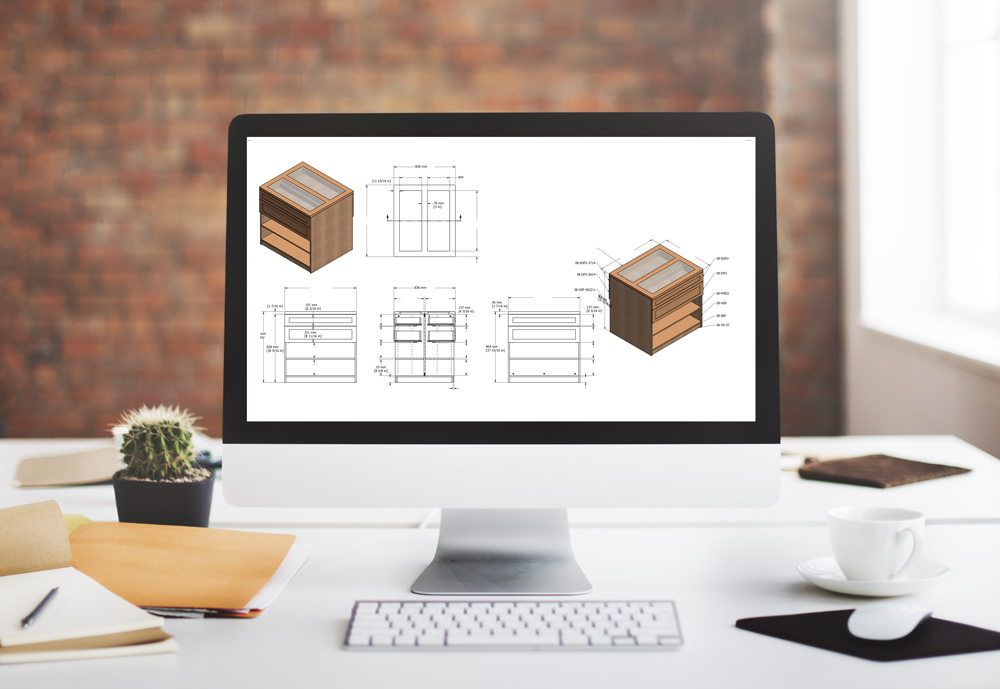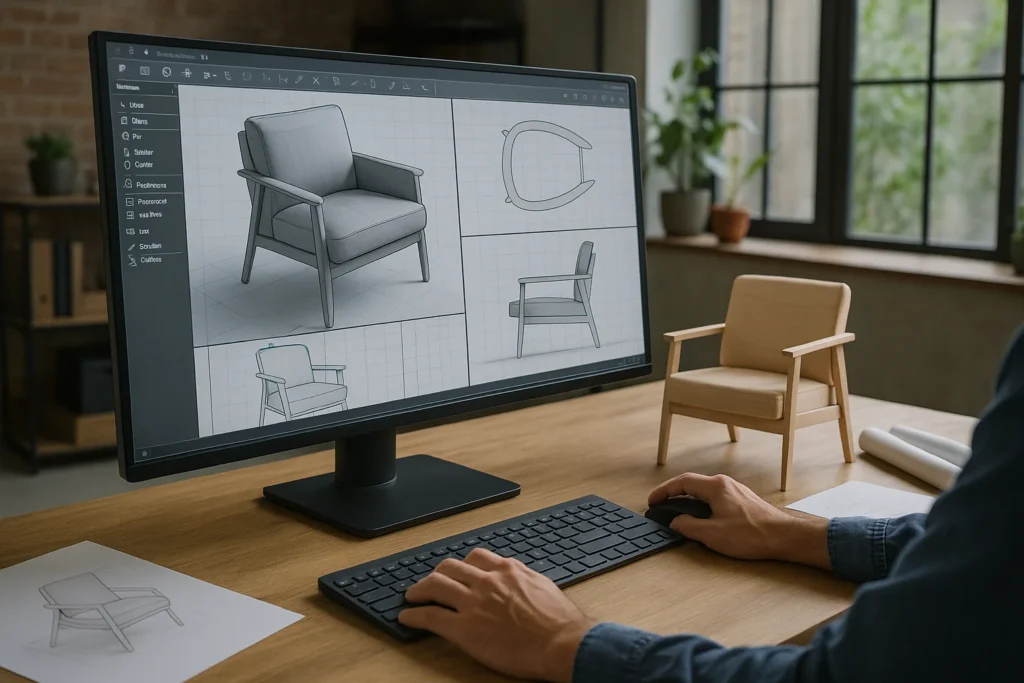
In an era where technology permeates every aspect of our lives, the field of furniture design is no exception. As traditional methods make way for innovative approaches, Computer-Aided Design (CAD) has emerged as a game-changer. Shalin Designs, a leading provider of Furniture CAD Design Services, is at the forefront of this revolution, leveraging cutting-edge technology to redefine how furniture is conceived, developed, and brought to life. This blog delves into the transformative power of CAD in furniture design and explores what the future holds for this dynamic industry.
Understanding CAD in Furniture Design
Computer-aided design, commonly known as CAD, involves the use of computer software to create precise drawings and technical illustrations. In furniture design, CAD facilitates the creation of detailed 2D and 3D models, enabling designers to visualize their concepts with unparalleled accuracy. This technology streamlines the design process, from initial concept to final production, ensuring that every detail is meticulously planned and executed.
Ready to See What’s Next in Furniture CAD?
The future of design is digital, sustainable, and limitless. Let CAD redefine your design journey.
The Advantages of CAD in Furniture Design
Enhanced Precision and Accuracy
One of the primary benefits of CAD in furniture design is the precision it offers. Traditional hand-drawn sketches can be prone to errors, but CAD software allows designers to create exact measurements and intricate details. This accuracy is crucial in ensuring that the final product meets the desired specifications and quality standards.
Efficient Design Iterations
CAD software enables designers to quickly modify and refine their designs. This flexibility is invaluable during the prototyping phase, where multiple iterations are often necessary. Designers can experiment with different materials, shapes, and sizes without starting from scratch, significantly reducing the time and cost involved in the design process.
Realistic Visualization
With CAD, designers can create highly realistic 3D furniture models that offer a true-to-life representation of the final product. This capability is particularly useful when presenting designs to clients or stakeholders, as it provides a clear and tangible vision of the proposed furniture piece. Realistic visualizations help in gaining client approval and making informed design decisions.
Streamlined Collaboration
Modern CAD software often includes collaborative features that allow multiple designers and engineers to work on the same project simultaneously. This collaborative approach ensures that all team members are on the same page, promoting seamless communication and coordination. Shalin Designs utilizes this feature to enhance teamwork and deliver exceptional results to their clients.
The Role of CAD in Custom Furniture Design

Custom furniture design requires a high level of creativity and attention to detail. CAD technology plays a pivotal role in bringing unique and personalized designs to life. By using CAD, designers can create custom pieces that cater to the specific needs and preferences of their clients. Shalin Designs excels in transforming 3D models into 2D furniture design drawings, ensuring a smooth manufacturing process for custom-built furniture joinery products.
To explore the latest trends and innovative ideas in furniture design for this year, you can visit Furniture Design Ideas in 2025. This resource provides comprehensive insights that can inspire and guide both designers and clients in creating exceptional and customized furniture pieces.
Tailored Designs
CAD allows designers to tailor furniture designs to individual specifications. Whether it’s a bespoke dining table or a custom bookshelf, CAD software enables designers to incorporate unique features and intricate details that reflect the client’s vision. This level of customization is challenging to achieve with traditional design methods.
Material Optimization
Selecting the right materials is a critical aspect of custom furniture design. CAD software provides designers with tools to experiment with different materials and assess their impact on the overall design. This capability ensures that the final product not only looks aesthetically pleasing but is also durable and functional.
The Future of CAD in Furniture Design
As technology continues to evolve, the future of CAD in furniture design looks promising. Several trends are shaping the future of this industry, offering exciting possibilities for designers and manufacturers alike.
Integration with Virtual Reality (VR) and Augmented Reality (AR)
The integration of CAD with VR and AR technologies is poised to revolutionize furniture design. These immersive technologies allow designers to create virtual environments where clients can interact with and experience furniture designs in real-time. This interactive approach enhances client engagement and provides valuable insights into the design’s functionality and aesthetics.
Artificial Intelligence (AI) and Machine Learning
Artificial Intelligence and Machine Learning are making their way into CAD software, offering advanced design capabilities. AI-powered tools can analyze design patterns, suggest improvements, and even automate repetitive tasks, allowing designers to focus on more creative aspects of the project. Shalin Designs is exploring the potential of AI to further enhance their design processes and deliver innovative solutions to their clients.
Sustainable Design Practices
Sustainability is becoming a key consideration in furniture design. CAD software enables designers to incorporate sustainable practices by optimizing material usage, reducing waste, and exploring eco-friendly materials. The future of CAD in furniture design will see a greater emphasis on sustainability, aligning with the growing demand for environmentally responsible products.
Cloud-Based CAD Solutions
Cloud-based CAD solutions are gaining popularity due to their flexibility and accessibility. These platforms allow designers to access their projects from anywhere, collaborate with team members in real-time, and store large design files securely. Shalin Designs is leveraging cloud-based CAD solutions to enhance its workflow and provide its clients with seamless design experiences.
Challenges and Opportunities
While the future of CAD in furniture design is bright, it also presents certain challenges. The rapid pace of technological advancements requires designers to continuously update their skills and stay abreast of the latest trends. Additionally, the initial investment in advanced CAD software can be significant. However, the long-term benefits, including improved efficiency, precision, and creativity, far outweigh these challenges.
The advent of CAD technology has undoubtedly transformed the landscape of furniture design. From enhancing precision and efficiency to enabling realistic visualizations and custom designs, CAD has become an indispensable tool for modern designers. As technology continues to evolve, the future of CAD in furniture design holds immense potential, promising exciting innovations and sustainable practices.
Conclusion
Shalin Designs, with its expertise in Furniture CAD Design Services, is committed to embracing these advancements and delivering exceptional design solutions to its clients. By staying at the forefront of technology, Shalin Designs ensures that its clients benefit from the latest innovations in furniture design. For those looking to find the best service provider in this field, it’s essential to consider companies that offer comprehensive Furniture Design Service Provider expertise, showcasing a blend of creativity and technical precision. This ensures that every design is aesthetically pleasing, structurally sound, and feasible for production.
If you’re looking to bring your furniture design visions to life with precision and creativity, Shalin Designs is here to help. Our expert team leverages the power of CAD technology to deliver custom furniture designs that exceed your expectations. Contact us today to discover how we can transform your ideas into stunning reality. Visit our website at Shalin Designs to learn more about our services and start your design journey with us.